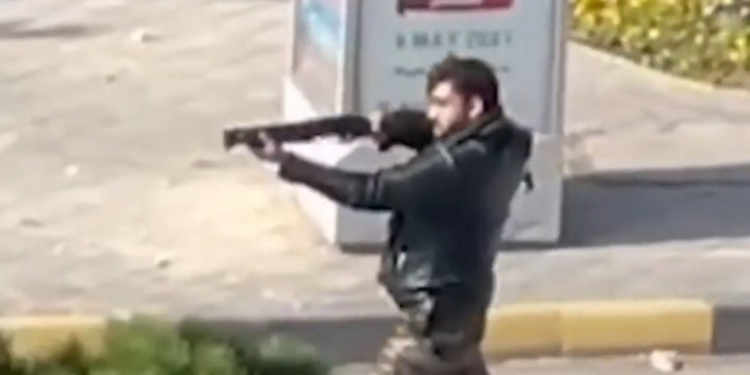On Friday, the 3rd of December, people of Isfahan called for a mass religious ritual: the Friday Prayers to be joined in on a dried riverbed that runs through the city. The Iranian religious authorities on any other day would welcome any conformist religious convention such as the Friday Prayers. However this time, the city of Isfahan faced a massive raid by security forces to prevent this religious assembly.
Isfahan citizens, symbolically, wanted to conduct their prayers on the dry riverbed of Zayandeh-Rood. This clever decision happened after a brutal, violent, and fatal crackdown of farmers’ peaceful gathering on the same riverbed a few days earlier. The farmers had gathered on the riverbed to express their dissatisfaction about the severe water shortage and water policies of the state.
Iranian authorities insist that the environmental crisis in the country is happening “naturally” because of drought, and they reject claims of mismanagement. However, they do not hesitate to use their violent pattern of behavior to suppress dissatisfaction over this “act of nature.”
The crackdown on the peaceful rally of farmers and residents of Isfahan, the country’s third-largest city, was very violent. The Center for Human Rights in Iran said that based on its investigations, 120 people were arrested in Isfahan. Videos posted on social media show that armed security forces shot and badly injured protesters, targeting protesters’ heads and blinding several protesters. The judicial system of the Islamic Republic confirmed 130 arrests (+).

Peaceful Protest of Farmers, the Brutal Response of the Regime, and World’s Reticence
News about Iran’s military interventions in the region, the country’s negotiations with world powers to revive the 2015 nuclear deal, and the dissatisfaction of Israel and the US right-wing politicians with these talks, dominate the coverage of the Western media about Iran. The news about the nuclear negotiations is probably not the only and the main concern of every Iranian. Only a few days before the new round of nuclear talks, the violent suppression of farmers’ peaceful protests in Isfahan shocked the country.
In late November, shortly before the onset of the new round of the nuclear talks, Iranian farmers in Isfahan convened in thousands over severe water shortage and water mismanagement. They followed an ‘occupy movement’ pattern as they set up tents and refused to leave the dry riverbed of Zayandeh-Rood. This pattern of protesting with the protesters’ hesitancy to take on a visible anti-regime stance (such as chanting political slogans or carrying political banners) seemingly bewildered the regime. At first, the Isfahan farmers’ protest even got covered by the state-owned television. However, it did not take long until the Isfahan farmers received the same response that the Iranian regime shows to any political protest.

After a week of peaceful protest, the farmers’ tents and protest location were raided by the security forces. They started setting up tents on fire, beating up protestors with batons, shooting tear gas and bb guns, and detaining protestors. Videos on social media shows, fatal shooting with shotguns and bb guns that blinded according to one report 40 protestors in at least one eye (+).
This violent response was not unprecedented. Since July, Iranian farmers, as well as the urban and rural citizens have been protesting water shortage and living conditions in Khuzestan and several other provinces. Human rights groups have verified the identities of at least nine protestors that security forces killed during the water protests of summer 2021 in Khuzestan and other provinces who joined the protests.
As evidenced in Isfahan, climate movements and environmental protests are tolerated by the Iranian regime and suppression is the main response; very similar to the crackdown that formerly the regime in Iran has used against political dissidents, students, women and middle-class citizens that raised their voices to protest political issues. Only this time, the weapons of the Islamic Republic are targeting poorer residents in peripheral provinces, rural places, farmers, and workers, and now gatherings to express unrest because of the climate issues that are affecting the lives of every Iranian.
The regime, evidently, has no hesitation to use violence even to disperse a religious gathering, such as the Friday Prayers organized by farmers and workers who are suffering from environmental crises. The Islamic Republic is inevitably setting foot on a self-destructive course. The security forces of the regime, target the very Islamic foundation of this state when they prevent a Friday Prayer. By attacking workers and farmers, they also target the very same people that this state was founded upon their right – the unprivileged and the underserved.
Despotism against itself: IRI’s Self-Destructive Gamble
If the climate and environment crisis in Iran is an “act of nature” or “act of God,” as Iranian religious leaders might like to put it, then why is protesting such condition a felony?
Ahmad Alamolhoda, senior hardliner cleric and widely known as a figure close to IRI’s supreme leader has famously claimed that drought cannot be resolved by protest, but prayers (+). To the eyes of the religious clerics, it might be true that objection to God’s will is not conventional, but the people of Isfahan were conducting a very standard religious rite – they were praying. Friday prayer on the dry riverbed that once supplied the water for the city of Isfahan and all the farms in the province is not against the rule of sharia, nor against the Islamic traditions. Indeed, it is a very acceptable religious response to this catastrophe of not having enough water.

The behavior of the Islamic republic shows either they are skeptical about the very same Islamicness that the state is founded upon or worst, they have become non-believers. Forcefully preventing people from praying to God is an extremely ungodly, if not sinister or heretical deed. Then why does a religious regime commit heresy? Either it has not truly religious, or it is accepting that the environmental crisis is not an act of god and that it is happening at least partially because of man’s water management policies. Most likely, both scenarios are true.
Iran, as a country in the Middle East, has a history of battling water shortage and long-standing drought. On the other hand, other countries in the region, like Israel or the United Arab Emirates, are facing the same environmental conditions and planning strategies for it. Therefore, even the Islamic Republic of Iran, covertly though, acknowledges that the living condition of Isfahan farmers, as well as other people all around the country, is the result of decades of mismanagement.
Consequently, it should not be surprising that the security forces of the regime follow the same pattern to respond to environmental protesters as they typically respond to any political protestation. The environmental issues, in the eyes of Iranian authorities and most likely also, in actuality, are not happening only because of “natural reasons.” They are indeed the result of years of mismanagement, mishandling, corruption, and senselessness policies set forth by high-ranking officials both at the level of provinces and at the capital. Subsequently, any protest to the environmental conditions including the water crisis is also a political.
Both in the water protests of summer 2021, and the Isfahan farmers protests of November 2021, the protesters are not (only) students or middle-class middle-income urban inhabitants who demand freedom and better living conditions. The environmental protesters who are demanding access to water and better living conditions are from poorer populations, farmers, and ordinary urban and rural citizens that battle for their basic natural needs.
The battle between IRI and poorer Iranians started if not shortly after the 1979 revolution, but undeniably after the brutal suppression of recent years’ demonstrations (especially vast nationwide demonstrations in November 2019 known as Aban-98). The new development of Isfahan water protests also shows that the IRI is not only battling poorer Iranians, but also religious Iranians. As a result, the Islamic Republic of Iran is now overtly contradicting itself by prohibiting one of its dominant origins; the Friday Prayer.
All in all, Isfahan’s instance clearly demonstrates the novel transformation of the Islamic Republic regime – the transformation from a religious authoritarian regime, to a full military dictatorship. The Islamic Republic is so close to confessing that is not a successor of another self-centered regime, but a logical continuation of what was going on in Iran before the 1979 revolution: a military dictatorship.








